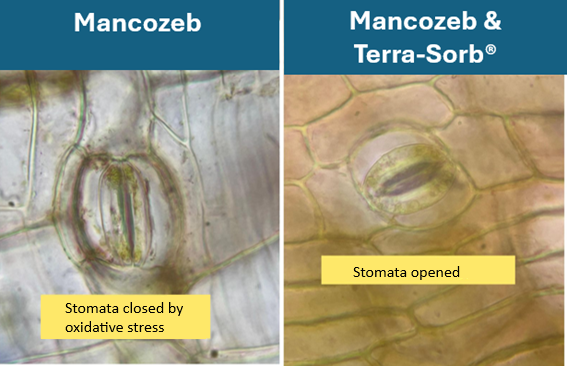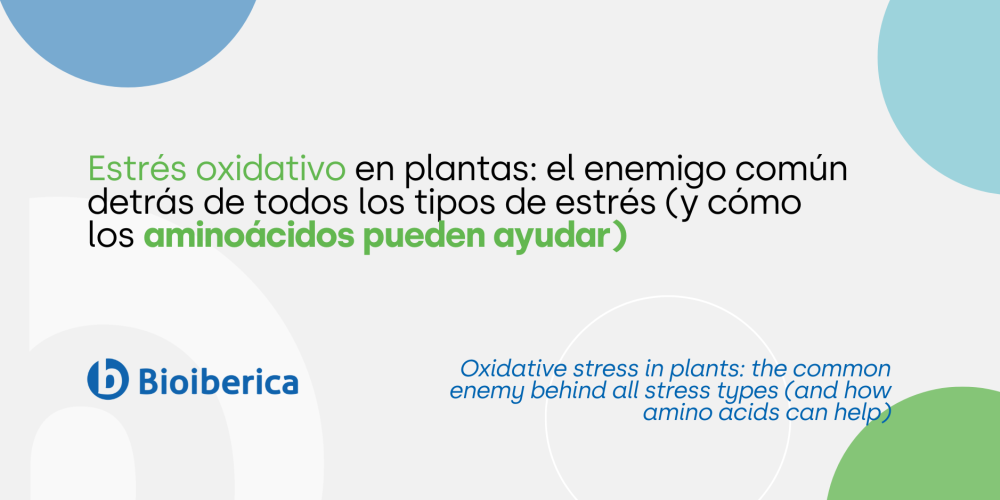Oxidative stress in plants: the common enemy behind all stress types (and how amino acids can help)
Drought, heat, pathogens, repeated pesticide applications… all these factors share a common outcome: they trigger oxidative stress in plants. A silent yet decisive process that affects photosynthesis, growth, and ultimately, yield.
In this article, we explain what oxidative stress is, why it happens, and how products such as Terra-Sorb®, based on free amino acids (99% L-form purity) and bioactive compounds, can help neutralise and reverse its effects.
What is oxidative stress in plants?
Oxidative stress occurs when reactive oxygen species (ROS)—free radicals and oxidising compounds such as superoxide, hydrogen peroxide, or singlet oxygen—accumulate in excess.
In small amounts, these molecules are useful: they act as defence and signalling messengers. However, when their production exceeds the plant’s antioxidant capacity, damage begins to appear—oxidation of lipids, proteins and pigments, membrane disruption, and loss of photosynthetic efficiency.
All types of stress converge into it
No matter the source:
- Drought limits CO₂ uptake and overloads chloroplasts.
- Heat and salinity disrupt cellular respiration.
- Pathogens induce defence responses that also generate ROS.
- Even some chemical treatments, such as fungicides, can alter the redox balance.
In all cases, the result is the same: overproduction of ROS and, if not counteracted, oxidative damage.
Physiological and agronomic consequences
Excess ROS directly impacts plant metabolism:
- Damage to cell membranes and loss of integrity.
- Destruction of pigments and photosystems, reducing photosynthesis.
- Disturbance of energy metabolism, affecting growth and flowering.
- Decrease in yield and fruit quality.
Oxidative stress largely explains the loss of vigour and yield variability observed in many crops under adverse conditions.
Case study: fungicides and black Sigatoka
In the management of diseases such as black Sigatoka (Mycosphaerella fijiensis) in banana, certain fungicides—although essential for controlling infection—can induce oxidative imbalances.
Dr Miguel Beltrán-García (Autonomous University of Guadalajara) demonstrated that in the plant–fungus interaction, singlet oxygen (¹O₂) is generated—a highly reactive form of oxygen responsible for much of the cellular damage seen in infected leaves.
This example illustrates how even protective strategies may generate secondary oxidative stress, temporarily reducing the crop’s photosynthetic capacity.
In banana trials, Terra-Sorb® (TB) application maintained open and stable stomata, indicating absence of stress and a balanced physiological state. Conversely, treatment with Mancozeb at different doses caused marked stomatal closure and cellular alterations, signs of severe stress associated with ROS accumulation, compromising photosynthesis and redox metabolism.
Finally, the Mancozeb + Terra-Sorb® (TB) combination mitigated this negative effect, showing more open or partially functional stomata thanks to the biostimulant’s protective action, which activates antioxidant pathways, regulates redox-related genes and enhances osmotic stability.

Fig. 1. Effect of Mancozeb and Mancozeb + Terra-Sorb® on stomatal aperture in banana leaves.
How Terra-Sorb® helps reverse oxidative damage
Biostimulants based on free amino acids (99% L-form purity) and bioactive compounds—such as Terra-Sorb®—can help restore the plant’s metabolic balance through several complementary mechanisms:
- Supply of antioxidant precursors: amino acids such as tryptophan, proline, arginine, glutamic acid, cysteine and glycine are essential for this function.
- Stimulation of antioxidant enzymes (SOD, CAT, APX), enhancing the capacity to neutralise ROS.
- Recovery of metabolism and photosynthesis, by promoting protein synthesis and energy balance.
- Rapid foliar absorption, ideal for post-stress treatments or combination with crop protection programmes.
The result: plants with greater recovery capacity, reduced oxidative damage, and better preservation of their productive potential after environmental or chemical stress.
Black Sigatoka is a fungal disease that induces oxidative stress in the plant, manifested as leaf burns and reduced photosynthetic capacity. Terra-Sorb® helps mitigate the oxidative stress caused by the pathogen, allowing for lower doses of certain fungicides (such as Mancozeb) without compromising disease control efficacy—thus contributing to a reduced chemical load.
Practical recommendations
- Apply Terra-Sorb® preventively or in combination with protective or systemic fungicides that may generate oxidative stress.
- Integrate its use within a holistic crop management strategy that combines balanced nutrition and responsible plant protection practices.
Conclusion
Oxidative stress is the “common denominator” among the different types of plant stress. Understanding and acting upon it helps reduce accumulated damage and maintain yield.
Biostimulants based on free amino acids (99% L-form purity) and bioactive compounds—such as Terra-Sorb®—are effective allies in helping plants restore their redox and physiological balance, safeguarding productivity against the challenges of the field.

